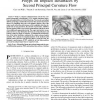Free Online Productivity Tools
i2Speak
i2Symbol
i2OCR
iTex2Img
iWeb2Print
iWeb2Shot
i2Type
iPdf2Split
iPdf2Merge
i2Bopomofo
i2Arabic
i2Style
i2Image
i2PDF
iLatex2Rtf
Sci2ools
TMI
2010
2010
Detection and Segmentation of Colonic Polyps on Implicit Isosurfaces by Second Principal Curvature Flow
Abstract--Today's computer aided detection systems for computed tomography colonography (CTC) enable automated detection and segmentation of colorectal polyps. We present a paradigm shift by proposing a method that measures the amount of protrudedness of a candidate object in a scale adaptive fashion. One of the main results is that the performance of the candidate detection depends only on one parameter, the amount of protrusion. Additionally the method yields correct polyp segmentation without the need of an additional segmentation step. The supervised pattern recognition involves a clear distinction between size related features and features related to shape or intensity. A Mahalanobis transformation of the latter facilitates ranking of the objects using a logistic classifier. We evaluate two implementations of the method on 84 patients with a total of 57 polyps larger than or equal to 6 mm. We obtained a performance of 95% sensitivity at four false positives per scan for polyp...
| Added | 22 May 2011 |
| Updated | 22 May 2011 |
| Type | Journal |
| Year | 2010 |
| Where | TMI |
| Authors | Cees van Wijk, Vincent Frans van Ravesteijn, Frans M. Vos, Lucas J. van Vliet |
Comments (0)

